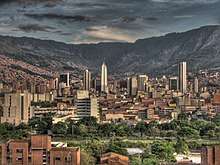Second Episcopal Conference of Latin America

The Conference of Latin American Bishops was a bishops' conference held in 1968 in Medellín, Colombia. In this conference, the bishops agreed that the church should take "a preferential option for the poor." The bishops decided to form Christian "base communities" in which they would teach the poor how to read by using the Bible. The goal of the bishops was to liberate the people from the "institutionalized violence" of poverty. They informed the people that poverty and hunger were preventable.
The movement drew on the influence of Paulo Freire, widely regarded as the greatest literacy teacher of the region, along with Father Camilo Torres and Bartolomé de Las Casas. It allowed for the poor to object to the hegemony and hierarchy they had been subjected to for the past centuries. Instead of accepting only what they were given, the people could now demand more, like soup kitchens, day care, co-ops, neighborhood organizations, higher wages, and better medical care. The bishops and nuns that took part in this effort were hoping that the "religious fervor" of the region would help make the result extremely powerful. They felt that the poor were the blessed people and that the church has a duty to help them.
The movement eventually became known as "liberation theology." Many associated the movement with Marxism. Pope John Paul II, a staunch opponent of Communism from his experience of it in Poland, started a campaign in the 1970s that would overthrow "liberation theology" by appointing bishops in Latin America that were hostile towards it. Joseph Cardinal Ratzinger, later Pope Benedict XVI, as Prefect of the Congregation for the Doctrine of the Faith, was in charge of enforcing doctrine which largely opposed the theological interpretations and actions of these Latin American religious leaders. Later in 1983, the Pope visited Nicaragua in order to show his opposition to the Sandinista revolutionary leaders, due to the movement's increasing use of violence. In the visit the Pope shouted "Silence!" three times at the Sandinista crowd when they heckled him; some interpreted this as symbolizing his "silencing" of the theology and those who supported it.
Background
In 1931, Pope Pius XI had put forward a vague plan for a sort of moderate corporatism. However, he also pushed for both Catholic and non-confessional labor unions. Though these unions were likely more akin to medieval guilds in the Pope’s vision, unions at this time were beginning to be associated with workers rights and class struggles. By the 1950s and 1960s, Christian Democratic parties and Catholic labor associations were on the rise. Members were tasked with bringing Christian values and principles into public life. Papal teachings emphasized the “re-Christianizing” of society and based on cooperation for the common good.
While the Christian Democratic Parties began advertising their “Third Way” as an alternative to both Capitalism and Socialism, a small divide formed within the Christian Democratic Parties between the “Liberationists” and the moderate conservatives in control. The Latin American Episcopal Council (Spanish: Consejo Episcopal Latinoamericano), also known as CELAM, organized the conference in Medellin in order to put structure to the directions of the Church in Latin America. It was common to see the contradictory nature of the documents from the 1968 conference as the new Liberationist movement overtaking the older, conservative principles. However, according to Gustavo Gutiérrez, the author of A Theology of Liberation, claims that this is due to the bishops attempt to reach all Latin American communities, no matter where they stood and began introducing more Liberationist views.
See also
References
- Gutiérrez, Gustavo. A Theology of Liberation: History, Politics, and Salvation. Maryknoll, N.Y: Orbis Books, 1988. Print.
- William T. Cavanaugh. ""The Ecclesiologies of Medellin and the Lessons of the Base Communities"" Cross Currents Vol. 44 Iss. 1 (1994)
External links
| Wikiquote has quotations related to: Second Episcopal Conference of Latin America |